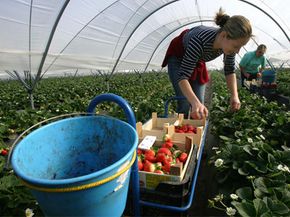Uses for Greenhouses
A greenhouse can extend a plant's growing season by a few weeks, or it can create a complete microclimate that's a successful substitute for the plant's native environment. From its origins as an indulgence for the wealthy and privileged, greenhouses are now used in many important and unexpected ways to help man understand and make use of the natural world.
Since World War II, there's been a huge increase in the commercial use of greenhouses to feed the world's population. In temperate climates, greenhouses extend the growing season and protect plants from harsh weather conditions. In higher latitudes, greenhouses increase plant production by optimizing the available light. Even in hot, arid regions, specialized greenhouses have been developed that can help lower temperatures and manage water loss in plants due to transpiration.
Advertisement
Cultivating attractive and hardy plants for commercial nurseries and florists is a thriving industry that relies on greenhouses to create perfect, pest free plants.
In many areas, controlling the environment inside a greenhouse is easier and more reliable than trying to manipulate all the variables of growing delicate plants outdoors.
Universities and research facilities around the world, like the Eden Project in St. Austell, England, are using the controlled environments in greenhouses to recreate specialized ecosystems in order to understand plants better. Greenhouse technology is making it easier to study the potential value of medicinal plants and explore ways to increase plant yields and make plants more disease resistant. Greenhouses are even being used to preserve plant species whose natural habitat is threatened. So let's take a look at how they work.
